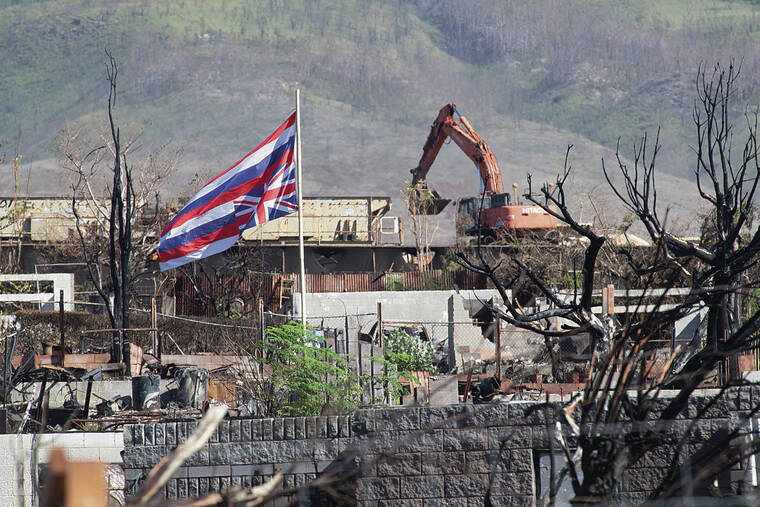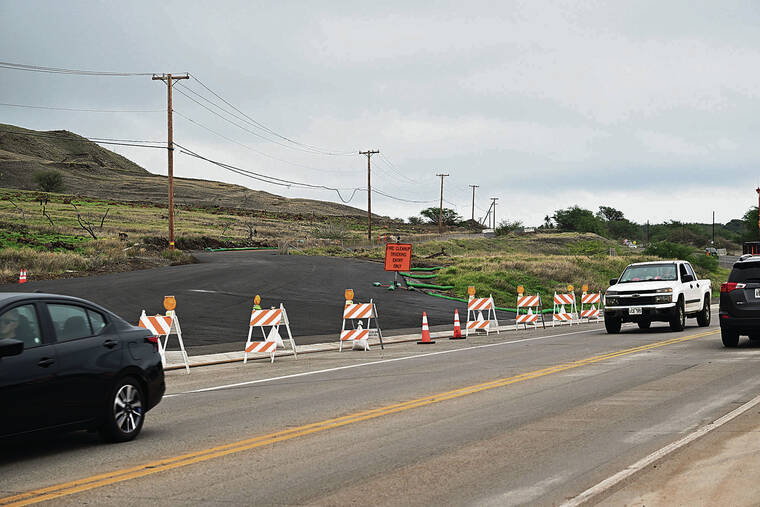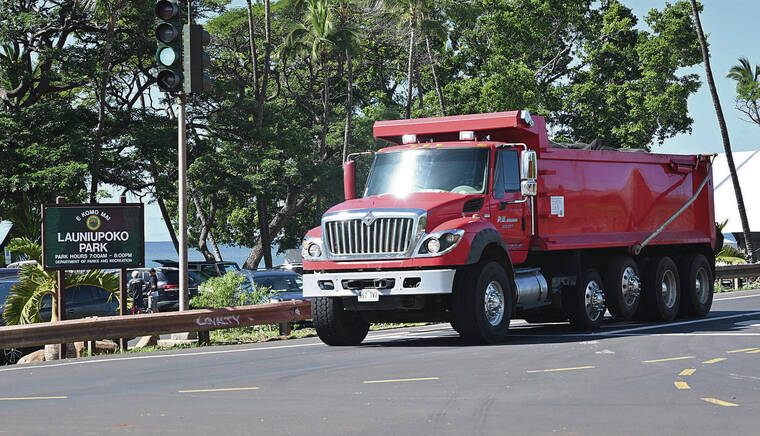Permanent Lahaina debris site narrowed to three locations

ANDREW VLIET / SPECIAL TO THE STAR-ADVERTISER / JAN. 16
Above, an excavator scoops up debris from Lahaina homes that were destroyed in the Aug. 8 wildfires.

ANDREW VLIET / SPECIAL TO THE STAR-ADVERTISER / JAN. 16
A roadway crossing Honoapiilani Highway was created for trucks transporting debris from the fire to a temporary storage site at Olowalu.

ANDREW VLIET / SPECIAL TO THE STAR-ADVERTISER / JAN. 22
A truck loaded with debris drives by Launiupoko Park along Honoapiilani Highway on Maui.



Two West Maui locations and the Central Maui Landfill have been chosen as the finalists for the permanent disposal site for the ash and debris from the Lahaina wildfire.
The sites were unveiled Wednesday night at the county’s weekly disaster recovery community update meeting at the Lahaina Civic Center.
At the same time, county officials launched a two-week community survey that will allow members of the public to give their input into the selection process. The final selection is scheduled for March 1.
“There is no perfect site,” said Shayne Agawa, director of Maui County’s Department of Environmental Management. “Not one site is going to make everybody happy.”
The two West Maui sites are north of Lahaina town: the Wahikuli area and Crater Village. Both sites are undeveloped, but the Wahikuli area is near residential areas and the coastline, and the Crater Village site could interfere with drinking water sources.
The Central Maui Landfill in Puunene has county-owned lands where the ash and debris can be buried, but it is located 26 miles from Lahaina and promises to dramatically affect traffic with all the trucks needed to haul the debris.
Don't miss out on what's happening!
Stay in touch with breaking news, as it happens, conveniently in your email inbox. It's FREE!
“Shipping debris off-island is not an option,” Maui Mayor Richard Bissen added.
Agawa said the community survey is not a vote of site preference. Rather, it will ask questions about what should be considered for the site selection.
“It will help our team to select the final debris site,” he said.
Agawa said consultants analyzed various data and helped the county whittle down the finalist sites, first to eight sites and now three.
The Army Corps of Engineers is currently overseeing the removal from Lahaina of an estimated 400,000 cubic yards of ash and debris — the equivalent of some five football fields filled five stories high. The ash and debris is being hauled to the temporary disposal site in Olowalu.
Some 200,000 tons of debris, things such as concrete and metal, will be recycled, officials said.
Agawa said the county is aiming for a March 1 site selection because there are concerns about the debris being left at Olowalu.
“It’s a temporary site, and it’s not meant to hold the debris for years and years and years, so we really need to find a final site that’s designed to contain this debris,” he said.
Meanwhile, the Maui County Council is eyeing a possible alternative to burying the Lahaina ash and debris: a proposal to turn the toxic mix into concrete.
Officials from a company known as Yummet told members of the Council during two committee meetings last month that it possesses technology to do just that, and the effort won’t cost the county anything because of the revenue Yummet would make on concrete sales.
Yummet CEO Brittany Zimmerman told members of the Council’s Disaster, Resilience, International Affairs and Planning Committee that the toxic debris and ash can be converted into constituent molecules and reassembled into carbon-negative concrete that is stronger than conventional concrete.
A $200 million plant would combine three processes: high-heat pyrolysis, water treatment and cement production to make a cement made entirely from waste products.
To produce the concrete, construction and demolition debris and industrial wastes and ashes would be added like rocks and sand are added to cement to make the concrete.
While pyrolysis, water treatment and cement production are systems that normally pollute, Yummet claims its plant would generate no pollution because of the unique type of cement it invented.
“This is really the linchpin,” Zimmerman told the committee. “If we don’t have that cement, the whole process doesn’t work for us. So it’s really important.”
Yummet, which operates a small-scale pilot facility in Minnesota, says it plans to build a full-scale plant on Hawaii island.
The Hawaii County Council approved a resolution last year urging the county to divert all municipal solid waste to an on- island facility that can convert it into things like carbon-negative concrete by 2026. The action followed presentations from Yummet.
Doug Adams, director of the county’s Department of Research and Development, toured the company’s pilot site in March, and he reported to the county’s Environmental Management Commission in June that he saw the process in action.
“I can say it is feasible, and it is scalable,” the Hawaii Tribune- Herald quoted Adams as saying.
During the meetings on Maui, Yummet got plenty of support from those who described its process as an ideal solution for not only the disposal of wildfire debris and ash but other solid waste.
But some were skeptical.
Alan Booker, a systems engineer who spoke over video from his home in Alabama, said Yummet’s proposal is complex and untested on a large scale. He said the process would take many years, a large budget and a lot of rigorous research to be proven out.
Booker and others urged caution.
“I’ve seen too many instances where small pilot projects, when they start to be scaled up, run into all kinds of issues,” he said. “I would recommend full due diligence by a third party before anything like this would be attempted at scale.”
South Maui Council member Tom Cook called the proposal “optimistic.”
“It takes somewhat of a leap of faith,” Cook said. “But I just want to share with the community that that type of forward thinking on our small island remote home is something that we should cautiously embrace.”
Cook said the project warrants scrutiny.
“But the community should recognize the potential benefits of being able to keep the money here,” he said. “So many tires (are) imported to the state that (they) have to be exported. If they could be transformed into fuel and not have to be exported, it would be an economic plus rather than an environmental negative.”





